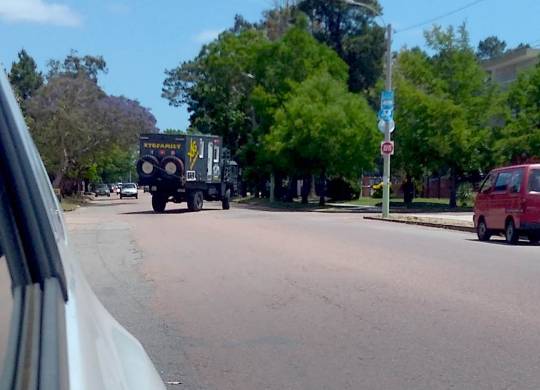
I had to pull over,roll down the window, and get out my phone in order to catch this monstrosity from France. So not a great photo, but: this is a vacation vehicle.
An inquisitive old fart with a camera

I had to pull over,roll down the window, and get out my phone in order to catch this monstrosity from France. So not a great photo, but: this is a vacation vehicle.

And not just because of sweltering days and Santa Claus. This is not the first European conquistador camper van I’ve seen, and no doubt won’t be the most outlandish, but there will be more. Mostly from Germany, but Swiss (this one), even French. All vying with the others to be the best equipped to handle the wild and challenging terrain of Uruguay, which has been described as “Iowa with beaches.”

Coche means car in Spanish.

Ridiculous? Unless this little truck has hydraulics I can’t even imagine how it got up the ramp to the Tienda Inglesa parking lot, much less navigates speed bumps and legion potholes (pozos) after the recent rains.
The antique Commer truck. September 2012:


December 2014 – mistakenly thought to be a different one:

January 2016: and yet again, parked at the zoo:

Alas, on a dreary day in 2019, that sad truck that appears to have finally reached the end of the line:

Interesting to reflect that this truck was built the year I was born. Happy to report I’m holding up better….
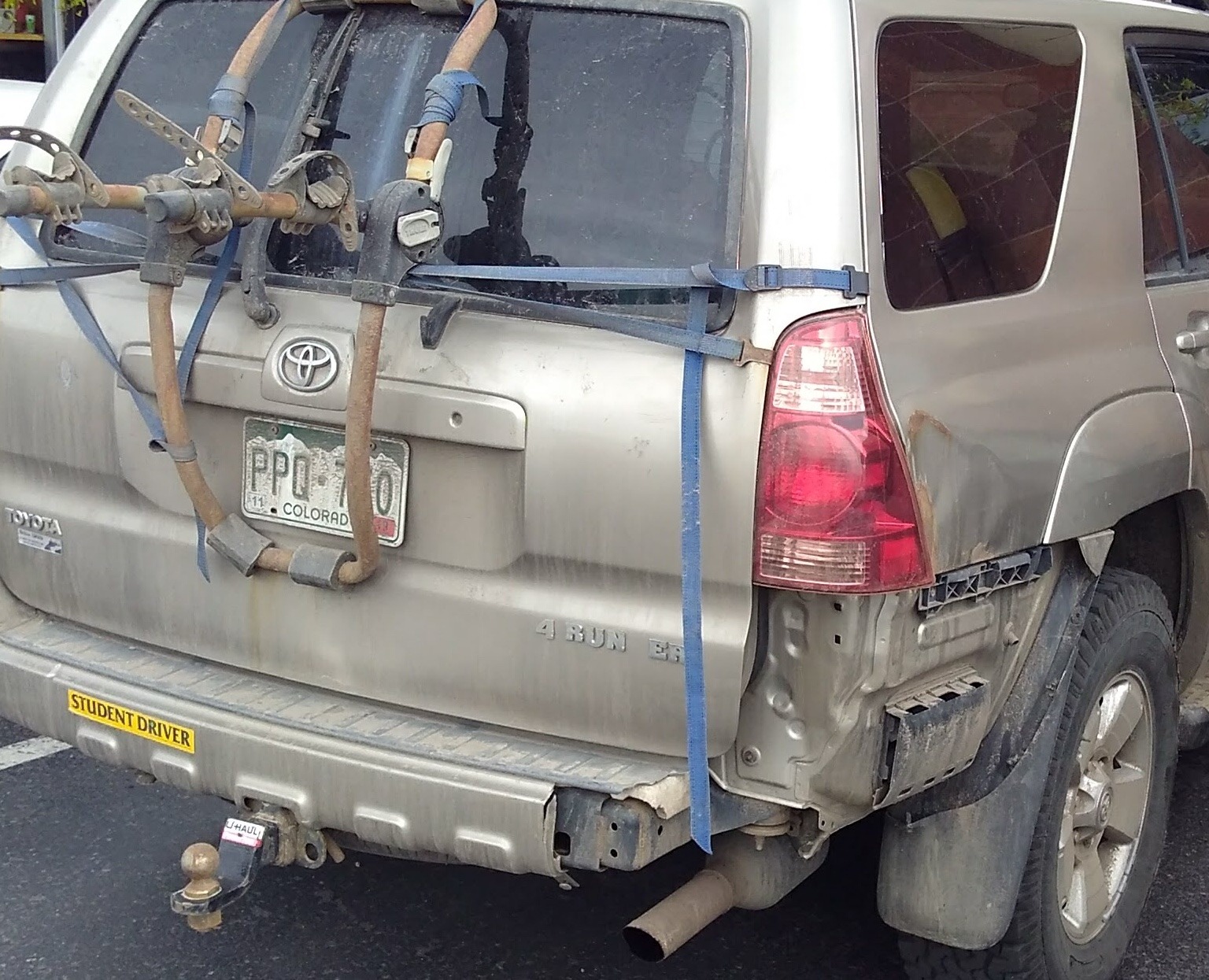
I’ve documented many times the overwhelming assault vehicles that Germans (and some others) apparently feel essential for navigating the wilds of the Americas. And to be fair, I personally know one who has made thorough use of its off-road provisions, in the Andes and elsewhere.
Mostly though, I see them parked in the dunes or supermarket parking lot. And those closeups often reveal fascinating evidence of wide-ranging travel.
As in, you know, suggesting maybe the vehicle was actually in those places at one point.
Enter the Pathfinder.
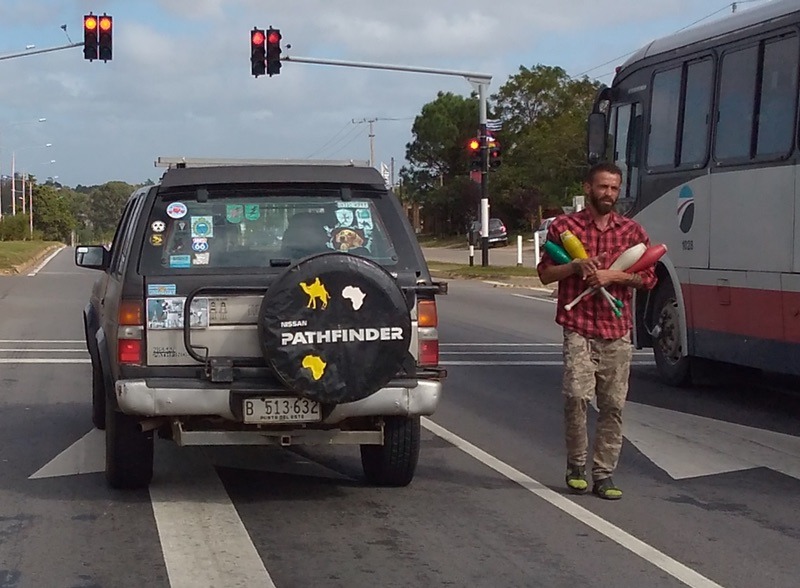
But first, an acknowledgement that a subset of Uruguayan drivers think stickers filling the back window comprise the essence of awesomeness. The vehicle below presented itself a few minutes later. Shooting through the windshield with the camera on my phone, I felt badly about the poor image quality … until I remembered there was nothing remotely interesting there to examine in greater detail.

So, the Pathfinder. First thing to notice are the wheels on the left. Their apparent offset could be explained by perspective, but no, you had to be there: through whatever misalignment, the car was driving somewhat crabwise.
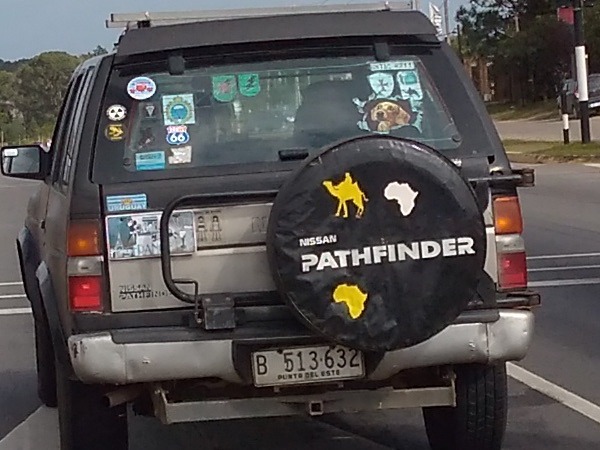
Then there are the stickers. Most prominent, a person on camel. Let’s see, Africa, eh? Or am I jusr cheating based on not one, but two, sticker outlines of the continent? So has this vehicle been to Africa (maybe twice?). Uh, no. Look 10:00 from there (with your ancient knowledge of analog clocks) and spot the Route 66 sticker. So this vehicle has traversed the southwestern United States? Uh, no.
Then on the window to the right, another camel, and then a dog peering through what might be a shrapnel hole. And then a cross motif, and … hmmm. Will I apologize that you can’t clearly see more? Uh, no.
By the way, no intent to denigrate the juggler, whom in this case I hardly noticed. Though considerably less novel than I’d prefer, unsolicited traffic light performers here are often quite impressive.
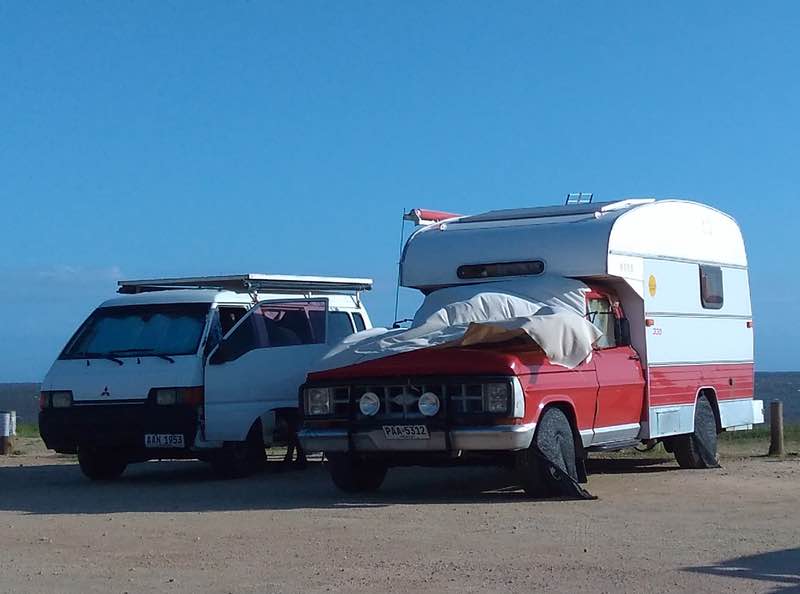
Local (Uruguay) campers. Looks like they’ve got it all sorted – solar panels, side awning, sun protection for the truck. There was a couple sitting with a little portable table between the two vehicles.
But: covering the tires to protect them from the sun? I guess maybe a good idea, but I’ve never, ever seen that before!
Montevideo Rambla, Ciudad Vieja. When we arrived here, late 2009, it was rare to see even a single vehicle parked along this stretch of road.

Consumer credit comes to Uruguay! At least that’s one explanation.
Car prices have fallen recently. This may involve poor budgeting by people new to credit, buying cars for only *so much* a month. Perhaps they don’t think about fuel (2.5 times the cost in the USA), maintenance, and insurance. Then enough of them figure out they really can’t afford a car, and try to sell it.
At any rate, it’s distinctly more difficult to find a parking place in Montevideo than a few years ago, to the point that I usually don’t even try, and head to a parking garage instead.
Our first Uruguayan passports, good for five years, were expiring. Arranging to renew them turned out to be relatively easy; done and paid online. When we got to the passport office, though, we lacked our credenciales civicas, which after a trip to the Corte Electoral, turned out to be big pieces of paper we got with our citizenship.
So, the next day we returned with those. No, they were supposed to be renewed after three years. Though an Uruguayan friend told me the credencia civica is nothing more than a voting card, it was indeed required for a passport (which she doesn’t have). The clerk this time had a printed paper we could take to the Corte Electoral, where the same friendly person said no, that’s not here, that’s a block away. So we went a block away, got numbers, and started the process until we got to the address part. We don’t have/can’t invent an address in Montevideo? Then we’ll have to go to the office in our departamento, Canelones. After a nice lunch in a new restaurant (rated #1 in Montevideo), we found the office, and got everything done – until my wife’s fingerprints. They just weren’t sufficient on four or five fingers. So: make appointment with dermatologist, come back with doctor’s note if this can’t be fixed, and we’ll proceed from there.
Booking a doctor appointment online with Asociación Española is also quite easy, but the soonest we could get to a dermatologist was a month away, in Montevideo.
Which is how we ended up there on Christmas Eve. Would there be such a thing as a routine doctor’s appointment on Christmas Eve up north? It somehow strikes me as unlikely.
Anyway, it was a snap. We returned the way we came, which involved me making a left turn at a traffic light which invoked a chorus of blaring horns: yeah, OK, don’t turn left in Montevideo.
Nice lunch at Lo de Mónica, near Géant and Macro Mercado supermarkets, where we spotted this.

I’ve posted many times about Uruguayan handwriting, how 9s look like Ps or lollipops, but this a first: a Y written as a 7.
OK, that’s anticlimactic. So here’s a cool Dodge Power Wagon we then saw in the Géant parking lot.
